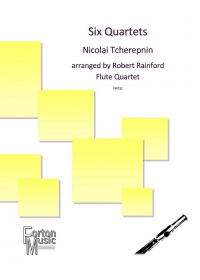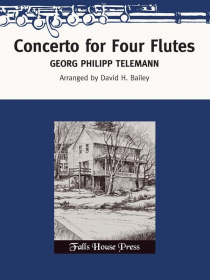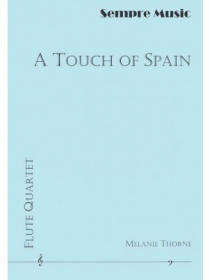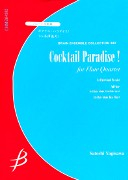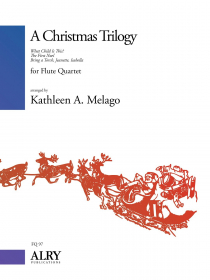4 Flutes (T-Z)
-
Sakai, I :: Good Morning!
Itaru Sakai's Good Morning!, for four c flutes paints a vignette as the sun rises, the plants begin their photosynthesis, and rich greens unfurl leaves and open to the sky.
For advanced players.
-
Taira, Y :: Fu-Mon
Fu-Mon
Taira, YYoshihisa Taira's Fu-Mon, for four flutes, lies in a similar vein to his seminal Maya or Shimazu's Moire and Evolution. Deeply strange, mysterious textures created through extensive extended notation and technique slowly give way to emerging melodic ideas. before slipping back into mystery. For advanced quartets.
-
-
Tamura, S :: Three Movements
Three Movements
Tamura, S
Shuhei Tamura presents Three Movements for flute quartet. Absolute music, specifically not associated with literature or paintings according to the composer.
Instrumentation: 4 C flutes, second doubling piccolo. Duration: 4:50.
-
Tchaikovsky, P :: 3 Dances (Nutcracker Suite)
3 Dances (Nutcracker Suite)
Tchaikovsky, PThese arrangements of three dances from Tchaikovsky's Nutcracker Suite for flute quartet included the Miniature Overture, the Dance of the Sugar Plum Fairy, and the Dance of the Reed Pipes.
Miniature Overture - A lively and intricate arrangement of the opening movement from The Nutcracker Suite. The inclusion of 2 piccolos helps to capture the 'miniature' character of the music, and the various tunes swap cheekily between the parts making it great fun to play and to listen to.
Dance of the Sugar Plum Fairy - The unusual combination of 3 piccolos and bass flute makes for an amusing and effective arrangement of this well-known dance from The Nutcracker Suite.
Dance of the Reed Pipes - The most flutey movement from The Nutcracker Suite in a brand new arrangement in the original key with the alto flute taking on the role of the pizzicato lower strings and the rich cor-anglais.
-
Tchaikovsky, PI :: Andante Cantabile
Andante Cantabile
Tchaikovsky, PI
One of the four movements from Tchaikovsky's 'String Quartet No. 1 in D Major,' arranged by Jennifer Higdon for flute choir. Instrumentation: Flute 1, Flute 2 - divisi, Alto Flute (or C Flute) - divisi, Bass Flute (or C Flute) - divisi
-
-
Tchaikovsky, PI :: Chanson Triste
Chanson Triste
Tchaikovsky, PIClair W. Johnson presents this arrangement for four flutes of Tchaikovsky's Chanson Triste. Includes score and parts.
-
Tchaikovsky, PI :: Jugendalbum op. 39 Acht Transkriptionen [Children's Album op. 39 Eight Transcriptions]
Jugendalbum op. 39 Acht Transkriptionen [Children's Album op. 39 Eight Transcriptions]
Tchaikovsky, PI
8 Transcriptions from Children's Album op. 39
-
Tchaikovsky, PI :: Nussknacker-Suite [Suite from the Nutcracker]
Nussknacker-Suite [Suite from the Nutcracker]
Tchaikovsky, PISabine Gunther presents this arrangement of four movements from the Nutcracker Suite - Danse Arabe, Danse Chinoise, Trepak, and Valse des Fleurs - for quartet of C flutes.
For advanced players.
-
Tchaikovsky, PI :: Quartet No. 1
Quartet No. 1
Tchaikovsky, PI
Tchaikovsky's great Quartet No. 1, arranged here for flute quartet. Structurally, this quartet uses the more standard classical forms, but using musical themes that are distinctly Russian.
The first movement is in sonata form. Its first theme is fluid, and the second is initially stated by the alto flute against rich harmonies in the other parts. These are then developed and restated in the recapitulation, before ending with a high-spirited coda. The second movement is based on the folksong 'Sidel Vanya', a traditional song from the Ukraine. The song is interspersed with highly expressive melodies, played twice over a staccato accompaniment. The third movement, marked 'Scherzo' has the robust, rhythmic character of a Russian peasant dance. The central trio pits the three upper instruments playing complex syncopated figures over a drone in the bass flute, before a repeat of the scherzo closes the movement. The Finale features two themes, an exuberant dance and a song of Slavic soulfulness. Both these themes are developed many ways before a sudden stop in the music. After a tiny, slower section, a whirlwind coda brings the music to a close.
-
Tchaikovsky, PI :: Three 'Nutcracker Suite' Dances
Three 'Nutcracker Suite' Dances
Tchaikovsky, PI
A superb transcription of Dance des Mirlitons, Marche, and Trepak. Instrumentation: 3 C Flutes, Alto Flute
-
Tchaikovsky, PI :: Zwei Tanze aus der 'Nussknacker-Suite' op. 71a [Two Dances from the 'Nutcracker Suite' op. 71a]
Zwei Tanze aus der 'Nussknacker-Suite' op. 71a [Two Dances from the 'Nutcracker Suite' op. 71a]
Tchaikovsky, PI
-
-
Tcherepnin, N :: Six Quartets
Six Quartets
Tcherepnin, NNicolai Tcherepnin was born in St. Petersburg in 1873. At his father's insistence he was trained in law, gaining a law degree in 1895. He continued to compose all through his studies, and in 1898 also earned a degree in composition under Rimsky-Korsakov. In 1902 he became the regular conductor of the Russian Symphony concerts; from 1909 to 1917 he was a professor at the St. Petersburg Conservatory. Whilst in this position he conducted the premier performance of Diaghilev's Ballets Russe and toured with the company around Europe. In 1918 he was invited to become the director of the National Conservatory of Tblisi in Georgia, but after the Bolshevik takeover in 1921 he moved to Paris, where he lived for the rest of his life.
These six miniature quartets were originally scored for four horns. Each is a beautifully crafted gem capturing a different mood and style. The Nocturne is still and calm; The Ancienne Chanson Allemande has a gentle folksy feel, and La Chasse is an energetic hunting scene. Choeur Danse is a lilting dance in triple time, Ancien Chanson Russe is a fugal treatment of a folk song, and the final Choral is an arrangement of JS Bach's chorale Wachet Auf. The lush romantic harmonies throughout are sustained by the four parts alone in a triumph of counterpoint.
-
-
Telemann, GP :: Concerto for Four Flutes
Concerto for Four Flutes
Telemann, GP
Telemann was one of the Baroque's most prolific composers, yet today he isn't as well known as Corelli, Vivaldi, Handel and Bach. His music is every bit as challenging and fun to play as that of his more famous contemporaries. This concerto for four flutes was originally written for four violins, and has been arranged in this exciting new edition so that it lies well on four C-flutes. The first part can also be performed on piccolo and the third and fourth parts become richer when they are performed on alto, bass and/or contrabass. This edition includes alternate alto flute parts to substitute for either flute 3 or 4, making this a very versatile concerto which sounds great when played on any of a wide number of possible combinations. The slow movements provide showcases for tone and intonation, and the allegro movements are very contrapuntal in nature, providing great opportunities for flutists to echo each other. The audiences will love this lively work from a less well-known giant of the Baroque.
-
-
Thorne, M :: A Touch of Spain
A Touch of Spain
Thorne, MThorne's original work for flute quartet does, indeed, capture A Touch of Spain with its rhythmic underpinnings and Spanish flair. All four parts are of equal weight and technical demand. For intermediate to advanced flutists.
-
Tomlinson, E :: Georgian Miniatures
Georgian Miniatures
Tomlinson, EErnest Tomlinson always enjoyed the music of the English 18th century composer, Thomas Arne, and felt that his music was unjustly neglected. In the early 1950s he made an orchestral suite using keyboard pieces by Arne which he called A Georgian Suite. Later, he was asked by one of his publishers to produce some background music in the Georgian style and he composed a suite which he called Georgian Miniatures. (He also later composed an individual orchestral piece called A Georgian Miniature just to add to the confusion!)
When his daughter, Hilary, asked him if he had any suitable pieces that could be arranged for her flute quartet he immediately thought of his Georgian Miniatures suite and arranged it for her. The suite was first performed at a concert in Settle, Yorkshire, by four flautists from Settle Orchestra, and remains a firm favourite.
If played by a group of four flautists of similar ability it is fun to change part for each movement, as was done in the first performance, so that each player gets a turn at playing tune and harmony parts.


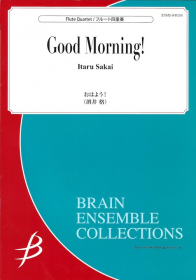




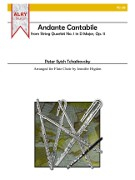

![Tchaikovsky, PI :: Nussknacker-Suite [Suite from the Nutcracker]](http://www.flute4u.com/var/images/product/262.280/P/D009790502361136_d.jpg)


